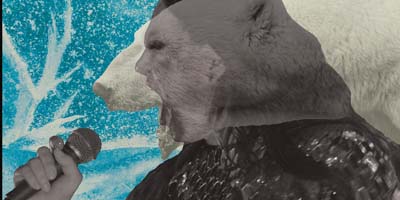Two women stand face to face, so close their lips will touch. Despite being at a viewpoint overlooking the expansive Nunavut territory, their unflinching eye contact locks them into an enclosed, intimate exchange. They are Inuk throat singers – their breath and song mirroring each other’s until someone breaks into a smile. One of them is Tanya Tagaq. This ten-minute close-up is the opening shot of Ever Deadly, an experimental documentary film about the life and music of Tanya Tagaq.
The film captures the sonic journey of the Inuk throat singer’s music by interspersing concert footage with shots of the Nunavut landscape, portraits of Tagaq and her family, and animated illustrations overlaid with poetry. Co-directed by Chelsea McMullan and Tagaq herself, we learn how her artistry is an embodiment of her relationship with land, her way of life, and the historical impacts of colonialism.
Tagaq performs in a dark and cramped venue, with fluorescent blue and red lighting creating the effect of an icy underworld. She explains that the show will be completely improvised, and jokes that for anyone who feels this isn’t their “thing” the door is very close by. The viewer is then immersed in the highly emotive and visceral experience of Tagaq’s performance, backed by a full band, a choir of vocalists and a dancer. The intimate nature of the concert is shown through close-ups of Tagaq’s face, beads of sweat dripping down her face, her mouth wide open. She calls herself a contemporary throat singer because, while grounded in the traditions of the art, she takes inspiration from heavy metal and experimental genres. For those not well-versed in her art – and perhaps even for those who are – there is a lot going on. And the documentary’s mixed-media style reflects this in a way that gives us a deeper understanding of what influences Tagaq’s musical narrative.
In contrast to the audiovisual saturation of the concert, the film shifts to the expansive land of Iqaluktuuttiaq (Cambridge Bay), Nunavut, where Tagaq is noticeably more at ease. She feels a deep sense of belonging when she is on the land rather than in the city, she says. The film gives us a peek into her way of life, her family, the hunt, the isolation and a relationship with the land that is her main source of inspiration. We see Tagaq playing with her children and remarking on the freedom they have to run wild by the ocean. Her mother makes an appearance in the film, notably telling the story of her community’s forced displacement from their home in Baffin Island in the 1950s by a resource-greedy Canadian government. Telling this story in the Inuktitut language, with footage of rallies bringing awareness to missing and murdered Indigenous women and girls, the film reflects the pain and trauma of colonialism that continue today.
The film does an excellent job at capturing Tagaq’s personality: her witty humor and charm, her leadership and boldness, her playful smile, but I felt like I only got a taste of her personal story and artistic inspirations, leaving me with unanswered questions. But perhaps it is this style of nonlinear and mixed-media filmmaking that properly reflects Tagaq’s musical storytelling, by creating a sense of improvisation, immediacy and connection.
Tanya Tagaq and Chelsea McMullan’s National Film Board of Canada (NFB) feature-length documentary Ever Deadly began screening in Canadian cinemas beginning January 20, 2023.



